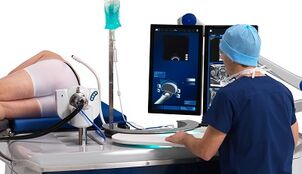Congestive prostatitis is a disease that occurs against the background of prostate dysfunction. The main reason for the development of the disease is congestion in the prostate. Such pathology can develop in men of all ages. Recently, the incidence of this disease in young people has become more frequent.
Causes

The appearance of stagnation in the prostate always indicates the development of an inflammatory process that prevents the proper functioning of the male prostate gland. The process of bleeding becomes difficult and the gland stops emptying completely, as a result of which stagnation of its secretion occurs.
Very often this disease develops against the background of chronic prostatitis. Therefore, the patient may not be aware of the presence of stagnant processes in his body for a long time.
Prostate congestion can occur for a variety of reasons. As a rule, this disease is non-bacterial and manifests itself due to the influence of the following factors:
- Lack of constant intimate life. Frequent arousal without subsequent ejaculation, intermittent sexual intercourse, incomplete ejaculation, frequent sex after prolonged abstinence can lead to stagnant processes.
- Anatomical features. If a person has insufficient venous valves or weakness of the walls of the veins of the urogenital plexus.
- Spinal cord injuries as well as diseases such as disc herniation or osteochondrosis. Prolonged spasm of the vessels of the prostate gland may occur with physical damage to the spine.
- Frequent hypothermia of the body, work in a room with active air conditioning, the presence of drafts, etc.
- Bad habits - smoking, alcohol abuse. As a result, the patient may experience paralysis of the small vessels of the genitourinary system.
- Chronic increase in pelvic temperature. This phenomenon can also be attributed to anatomical features.
- Frequent colitis and diarrhea.
- Eating problems, dehydration.
According to most experts, the main cause of stagnation lies in the varicose veins of the lower extremities. In this case, there is a violation of blood circulation to the pelvic organs, due to which the prostate begins to fill with blood.
Often the cause of the disease can be an inflammatory process localized in the pelvic organs or rectum. Also, the disease can be caused by hormonal disorders.
Various acute or chronic infections can also provoke stagnant processes in the prostate. Penetration of infection into the prostate gland occurs through the urethra. Also, infection is possible through the rectum, blood or lymph vessels.
Who is at risk

Constant sedentary work is a direct path to stagnant prostatitis.
Despite the fact that this disease develops suddenly, it can be prevented if the provoking factors are excluded from everyday life. At risk of developing stagnant processes in the prostate are:
- People with a sedentary lifestyle. First of all, we are talking about those people who work sitting down.
- Patients suffering from frequent constipation.
- People who eat irregularly and neglect healthy, nutritious food.
- Smokers and people with severe alcohol dependence.
Symptoms
In most cases, this disease is characterized by an asymptomatic course and therefore it is almost impossible to determine its presence at home. The first sign of the disease is the presence of pain in the perineal area. It usually gets worse when walking. Nevertheless, the disease has certain symptoms that need to be discussed in more detail.
The main symptoms of stagnant prostatitis are:
- Decreased strength and sexual desire. Deterioration of erection.
- Reducing the amount of sperm, reducing its consistency.
- Frequent premature ejaculation.
- Decreased quality of orgasm.
- Constant burning sensation in the urethra and bladder.
- Problems urinating, which is intermittent and painful.
- There is pain in the groin that extends to the sacrum or inner thigh.
- There is constant burning and discomfort in the bladder and urethra.
Non-specific symptoms of congestive prostatitis include general weakness, decreased ability to work, sleep disturbances and general irritability.
Classification
Currently, congestion in the prostate can be observed in the following types of prostatitis:
- Chronic.It usually develops in the absence of a regular sex life or its replacement by masturbation. Obesity, interruption of sexual intercourse, stress, poor blood supply, sedentary lifestyle - all these factors eventually lead to the development of chronic prostatitis. In chronic prostatitis, the ejaculate usually comes out in the form of clots. Prostate massage or intercourse can improve the patient's condition, but the effect will be short-lived.
- Venous.Occurs in the presence of pathologies of the venous system. If the patient is diagnosed with varicose veins, as a result of which there is an accumulation of venous blood in the venous system of the pelvis, then the stagnant processes can be localized in the prostate gland. The consequence of this is prostatitis.
- Stagnation.Occurs due to incomplete emptying of parts of the prostate gland, as a result of which it is constantly in a state of blood transfusion, which contributes to the development of inflammation. This form of prostatitis is most common in middle-aged men.
- Contagious.In this case, the cause of the disease is an infection that enters the prostate gland through the genitourinary system. If this occurs against the background of the course of cognitive prostatitis, then the inflammatory process increases and the general condition of the patient deteriorates.
Diagnostics

Echotomography of the prostate will help to accurately determine the picture of the disease.
Diagnostic measures must include palpation of the prostate, as well as examination of the posterior urethra. This is the basis for diagnosing prostatitis, which allows the specialist to determine whether the sensitivity is low or high. Also, the presence of disease is evidenced by the secretion of scarce aseptic secretions.
In addition, if the doctor suspects the development of the disease, the patient is sent for prostate rheography. This procedure is well tolerated by patients, taking an average of about fifteen minutes. According to the results of the rheography, it is possible to identify disorders of venous outflow, to obtain basic information about the condition of the vessels - their elasticity and integrity.
If the blood flow to the glandular tissues is difficult, this indicates the presence of degenerative changes.
To confirm the diagnosis and get more information, the following procedures apply:
- Ultrasound of the pelvic organs.
- Echotomography of the prostate.
You can not do without laboratory diagnostic methods, which include passing the following tests:
- Urine tests.Includes general urine analysis, triple study and microflora culture. In the course of these analyzes, pathogenic microflora, including chlamydia, are most often not detected.
- Blood tests.We are talking about thromboelastography and coagulogram.
- Analysis of ejaculate and prostate secretion.Leukocytosis is most often not found in congestive prostatitis. However, the sample contains images of columnar and squamous epithelium.
Differences between congestive prostatitis and infectious

The disease is accompanied by frequent depression in men.
At the diagnostic stage it is very important to distinguish a stagnant process from an infectious one. Otherwise, the treatment will be chosen incorrectly, which can lead to some complications. Therefore, the specialist should pay attention to the following symptoms:
- Problems urinating - the patient usually urinates frequently in the morning. In addition, his condition is improving.
- Pain and burning pain in the perineum, testicles.
- Fever with severe general fatigue.
- Depression and general anxiety.
- Erection problems and weak orgasms. Ejaculate quality usually deteriorates in patients, which can be detected during further studies.
Initially, the doctor conducts palpation tests, during which they reveal certain changes in the prostate. We can talk about the following features:
- the organ is enlarged;
- the contours of the prostate are unclear;
- consistency changed;
- sensitivity increases;
- notes the smoothness of the contours of the middle groove.
Important!In the presence of the above symptoms, the patient shows no signs of infection during laboratory tests.
The secretion of the prostate is characterized by a thick consistency, which stands out in the form of lumps and clots. Similar changes are observed as a result of prostate massage. In some cases, the patient may notice lumps in the semen during ejaculation. This shows the development of a stagnant process.
Treatment
Treatment of the disease includes complete cessation of smoking.
The treatment of congestive prostatitis is determined based on the degree of its manifestation. Based on the results of an in-depth diagnosis, the specialist determines the course of further treatment. As a rule, it adopts an integrated approach and consists of the following procedures:

- Drug therapy.In the treatment of stagnant processes in the prostate, the patient should take anti-inflammatory drugs. The doctor may prescribe other medicines to his patient.
- Painkillersmay be prescribed for pain. They are usually taken with blood thinners.
- Power mode.When stagnant prostatitis is detected, the patient is subjected to a strict diet, including a limited intake of spicy and fatty foods. The key to a speedy recovery is a balanced diet, when the patient's daily diet contains a large amount of fruits, vegetables, fermented dairy products and oils.
- Sexual mode.It is very important for the patient not only to observe sexual hygiene, but also to improve his intimate life. Regular sexual intercourse will normalize the functioning of the prostate gland and will exclude the development of stagnant processes in the future.
- Give up bad habits.Many experts have no idea how congestive prostatitis can be treated with smoking or alcohol abuse. It is very important for the patient to completely give up smoking and drinking alcohol, which can cause the development of congestion. It is equally important to minimize such negative factors as hypothermia, physical overload, physical inactivity, etc.
- Physical activity.Most specialists prescribe special physiotherapy exercises for their patients. Such exercises are usually aimed at strengthening the abdominal muscles, improving breathing and toning the pelvic floor muscles.
- Vitamin therapy.This is a very important step in the treatment of stagnant prostatitis. The patient's body must receive the full range of nutrients. For this purpose, vitamin complexes are most often prescribed for patients with stagnant prostatitis.
If the cause of the development of stagnant prostatitis in men is valvular insufficiency of the veins of the lower extremities, then he is subject to surgery.
Prevention
In this case, the basis of preventive measures is activity. In addition, it must be manifested both in movement and in sex. Experts say that to prevent stagnation, the prostate gland must function regularly. Only ejaculation can provide this.
Moderate exercise, frequent walks and a normal diet will help prevent the development of this disease.
























